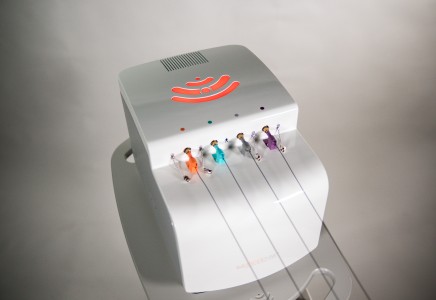Nuclear Physics Detector Tech Used in Cancer Treatment Monitoring System

The OARtrac® system features scintillating fibers that were originally developed for use in nuclear physics experiments.
Additional Links
Built with detector technologies used in nuclear physics experiments, the system monitors radiation treatments in hard-to-reach areas.
The Science
In nuclear physics, scientists routinely use scintillating material to help identify the particles produced in experiments. When more radiation impacts the material, it will emit a bigger signal, while less radiation elicits a smaller one. The Department of Energy has invested in developing such materials. Now, novel scintillating fibers are in an award-winning medical system. The system allows for active radiation monitoring when irradiating hard-to-reach cancers. The system can monitor areas in the body accessed with a thin catheter.
The Impact
For doctors, measuring exactly how much radiation cancer patients receive in real time is hard. The system allows clinicians to monitor and adjust the radiation delivered to patients. Such adjustments help patients get the specified radiation dose.
Summary
Nearly a half-million cancer patients are treated with radiation therapy every year in the United States. One challenge for treatment providers has been ensuring that each patient gets just what the doctor ordered. Now, key technologies used in basic nuclear physics research are helping to make that possible. In nuclear physics, scintillating material is routinely used to help identify the particles that are produced in experiments. When radiation hits scintillating material, it releases scintillation light corresponding to the amount of radiation that strikes it. The amount of this light can be calibrated to measure delivered radiation dose. The OARtrac® system includes technologies that are based on a novel application of scintillating material in fiber form. Doctors can insert these scintillating fibers into the human body via a catheter to monitor the radiation that cancer patients receive in a range of hard-to-reach areas. The system is designed to allow clinicians to monitor and potentially adjust the radiation delivered, so that patients receive the amount specified in their treatment plan.
Contact
Cynthia Keppel
Jefferson Lab
keppel@jlab.org
Funding
The Oartrac® system was designed and built by RadiaDyne, a subsidiary of AngioDynamics. Research involving the scintillating fiber technology and its adaptation for medical applications was supported by Hampton University and DOE’s Thomas Jefferson National Accelerator Facility.
Publications
Related Links
2018 MedTech Breakthrough Awards
November 2018

